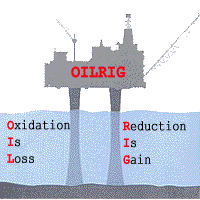| Oxidation is defined as loss of electrons, reduction is defined as gain of electrons. Reactions that involve electron transfer can be described in terms of reduction and oxidation. |
|
Reduction and oxidation reactions
These are reactions where electrons are transferred from one species (atom, molecule or ion) to another. We can write 'half' equations to show only what happens to the species losing electrons or a different 'half' equation to show the species gaining electrons. Logically when a species loses or gains electrons, it must change its oxidation number or state.
The whole oxidation and reduction equation (redox equation) is put together by balancing the number of electrons on both sides in each half-equation and adding them together (when the electrons cancel out).
Oxidation
This is the name given to removal of electrons from a species - the reagent causing the loss of electrons is called the oxidising agent
|
Example:
In this (half) equation the magnesium atom loses electrons and becomes an ion. |
Oxidising agents
These are the chemicals that cause the oxidation in a redox reaction. We call the reacting compounds in a reaction the reagents (short form of the words reacting agents).
We consider that the removal of electrons from a species is oxidation and these electrons have to be taken away by another compound or species. This species that attracts the electrons is said to be the oxidising agent, i.e. the reagent that causes the oxidation.
|
Example: Identify the oxidising agent in the following redox reaction:
The species that loses electrons in this reaction, i.e. the species getting oxidised, is the iodide ions.
Therefore the copper(II) ions are the oxidising agent. |
Reduction
This is the gain of electrons - the species donating the electrons is called the reducing agent
|
Example
In this (half) equation the iron(III) ion gains three electrons to become an atom. |
Reducing agents
The reagent that causes reduction in a redox reaction is called the reducing agent.
The oxidising agent takes the electron(s) and is itself reduced, the reducing agent loses the electron(s) and is itself oxidised.
|
2KI
|
+ Br2
|
|
2KBr
|
+ I2
|
||||
|
Iodide ions get oxidised
|
Bromine gets reduced
|
|||||||
|
Iodide - reducing agent
|
Bromine - oxidising agent
|
|||||||
|
Cr2O72-
|
|
|
2Cr3+
|
|
||||
| Chromium(VI) gets reduced | sulfur(IV) gets oxidised | |||||||
| Chromium(VI) oxidising agent | sulfur(IV) reducing agent |
|
Example: Identify the reducing agent in the following redox reaction:
The species that gains electrons in this reaction, i.e. the species getting reduced, is the iodine.
Therefore the thiosulfate ions are the reducing agent. |
Redox reactions
In a redox reaction one or more electrons leave one species and go to another. Consequently, reduction of one species has to be accompanied by oxidation of the other (and vice versa). For this reason reactions involving transfer of electrons are called reduction and oxidation, or redox for short.
|
Example
Two electrons from each magnesium atom are transferred to the iron(III) ions |
Finding the oxidised and reduced species in a redox reaction
This is a case of checking the oxidation state or number of an atom on the left hand side and comparing it with the same atom on the right hand side. If the oxidation number increases then the element has been oxidised, if it decreases then it has been reduced. The process can be done mechanically, which may be rather laborious, although after a little practise you start to recognise the atoms that are most likely to be involved.
|
Example: Which element is oxidised in the following redox equation?
Oxidation causes an atm to increase its oxidation number. Hydrogen is rarely involved unless the element appears on one side or the other. In this equation we can get a clue that iodine is part of the redox pair as there is elemental iodine on one side, but not the other. The oxidation state of an uncombined element is always zero. In potassium iodide, the iodine has an oxidation number of -1 (potassium is always +1). On the right hand side iodine has an oxidation number of zero. It has, therefore, increased its oxdation number from -1 to zero, it has been oxidised. |


